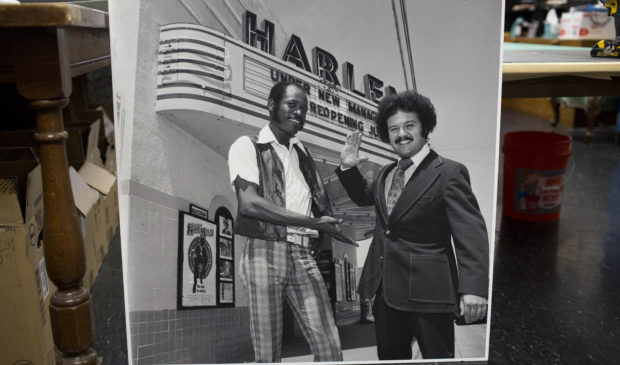Forty years after its fiery demise, a movie theater continues to be missed by East Austin
Wednesday, March 22, 2017 by
Audrey McGlinchy, KUT Ada Harden, 81, stands on a vacant lot at the corner of E. 12th and Salina Streets. While gravel and shorn grass crunch beneath her feet, she sees instead a maroon seat made of velvet and a wide screen where a fence now stands.
“Can you imagine a theater sitting right here?” Harden asked, giggling. She certainly can.
The Harlem Theater served East Austin moviegoers from 1935 until 1973, when it burnt down. For those who went to the theater, it was more than just a place to watch the latest Hollywood flick.

Ada Hardin
“It really was a meeting place for people young and old and in-between,” said Harden. “It was just being at home and being comfortable and knowing no matter what happens or whatever, wherever else, it’s just always comforting to know that this was here for us.”
Bertram Allen grew up in East Austin and started going to movies at the Harlem at the age of 7. “They called it ours,” Allen said. “It was our theater.”
In 1935, George Jones and his wife, Sadie, opened the Harlem Theater. According to cinema historian Dan Streible, a black-owned theater was a rare find in the early 20th century.
“There were certainly hundreds of movie theaters for black audiences across the United States. But the vast majority of those were white-owned or operated either by independent operators or chains of movie theaters,” said Streible, who wrote a chapter on the Harlem in the book Black American Cinema.
According to a book co-written by the curator of the Austin History Center, the Harlem was one of only seven black-owned theaters in the country at the time. And, compared to other theaters in Austin, where black customers were either not allowed or segregated to the balcony seats, the Harlem offered moviegoers their full rights.
“This was a place that you could come and feel like a full citizen and not feel less than or three-fifths of a person still,” said LaToya Devezin, a community archivist with the Austin History Center.
Many described it as more of a community center than a movie theater. “It was almost like church because all the community would come,” said Brenda Mims Malik, who attended the theater as a child in the 1960s.
Attached to the theater was a confectionary, where customers could buy takeout or concessions for the theater. Notable favorites included the chili burgers.
“You could smell those from way away even before you got to the theater,” said Harden.
As for what the Harlem might have shown, Streible said it would have been the usual Hollywood fare. Westerns were popular, said Devezin, in addition to horror films.
When Jones died in 1951, Sam Lucchese took over operations. He was the theater’s first white owner. While the family did not live in East Austin, according to his daughter, Sally Griffin, and others who attended the theater, Lucchese worked hard to be part of the fabric of the neighborhood surrounding the Harlem.
“He made it a point to be not just an absent owner of a property there or a business,” said Griffin, 71. “It always felt like a privilege to be there … to be able to be a part of what, as a child seemed to me like an important business because it was something that I understood that people enjoyed coming there.”
In December 1960, Lucchese was murdered outside the theater. A Variety article about his death described it this way: “Body of Lucchese was found in his car shortly after 1 a.m. The motor was running and the car lights were on. He had been shot once in the temple.”
There was $519.90 with Lucchese in the car, most likely from the ticket and concession sales. Griffin said she thinks her father was headed to the bank at the time of his killing. Three teenagers were charged, one with murder and the others with armed robbery.
“That shocked the whole neighborhood because very seldom were businesses ever being shot or robbed on this side of town,” said Allen.
Lucchese’s wife, June, tried to maintain ownership of the theater, but a year later she sold the Harlem. There are conflicting reports on how many different owners the theater had through the 1960s, but it’s clear that the theater closed for a short period of time. The last owners, a group of three men, purchased it in the early 1970s. They set about renovating the place.
“We just painted the entire theater,” said Dennis Baum, one of the theater’s last owners. “We gave it a new life and the community was just thrilled.”
But according to people interviewed for this story, the theater had already experienced its heyday. Baum agreed. When he and his partners reopened the theater in July 1973, they showed mostly blaxploitation films. In one photo of the marquee at this time, the films Cotton Comes to Harlem and Live and Let Die are listed.
But the theater’s resurgence was short-lived. On Dec. 30, 1973, it burnt to the ground. Neither the Austin Police Department nor the Fire Department has records of the fire. The community has only ideas about what caused it – perhaps arson, perhaps electrical fire – but no real answers.
“By that time we were allowed to go to other theaters,” said Malik. “But, you know, the Harlem was our heart and it was really a devastating blow for the community because it was a hallmark of our unity.”
Photo by Gabriel Cristóver Pérez/KUT News. This story was produced as part of the Austin Monitor’s reporting partnership with KUT.
The Austin Monitor’s work is made possible by donations from the community. Though our reporting covers donors from time to time, we are careful to keep business and editorial efforts separate while maintaining transparency. A complete list of donors is available here, and our code of ethics is explained here.
You're a community leader
And we’re honored you look to us for serious, in-depth news. You know a strong community needs local and dedicated watchdog reporting. We’re here for you and that won’t change. Now will you take the powerful next step and support our nonprofit news organization?










